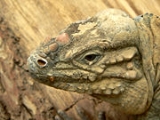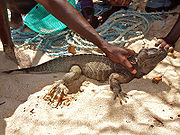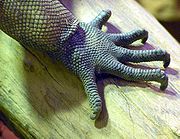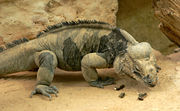
Rhinoceros Iguana
Encyclopedia
The Rhinoceros Iguana is a threatened species of lizard
in the family Iguanidae
that is primarily found on the Caribbean
island of Hispaniola
, shared by the Republic of Haiti
and the Dominican Republic
. They vary in length from 61 to 137 cm (2 to 4½ feet) and skin colors range from a steely gray to a dark green and even brown. Their name derives from the bony-plated pseudo-horn or outgrowth which resembles the horn of a rhinoceros
on the iguana's snout.
of lizard
belonging to the genus Cyclura
. The generic
name (Cyclura
) is derived from the Ancient Greek
cyclos (κύκλος) meaning "circular" and ourá (οὐρά) meaning "tail", after the thick-ringed tail characteristic of all Cyclura. The Rhinoceros Iguana's specific
name, cornuta, is the feminine form of the Latin
adjective cornutus, meaning "horned" and refers to the horned projections on the snouts of males of the species. The species was first identified by Pierre Joseph Bonnaterre
in 1789.
In addition to the nominate race (Cyclura cornuta cornuta) found on Hispaniola
, there are two other subspecies of Cyclura cornuta, the Mona Ground Iguana
(Cyclura cornuta stejnegeri) and the Navassa Island Iguana
(Cyclura cornuta onchiopsis), although the latter subspecies is believed to be extinct in the wild.
These iguanas are characterized by the growth of bony prominent tubercles on their snouts which resemble horns. Dr. Thomas Wiewandt, who spent an extended period on Mona Island studying Cyclura cornuta stejnegeri, suggested that the horns, along with lateral spines and prominent parietal bulges, function as protective armor against sharp rocks or as defensive tools to facilitate the escape of males from the grasp of one another. Males possess an adipose pad in the form of a helmet on the occipital
region of the head, and a large dewlap
. Males of this species, like other species within the Genus Cyclura, are larger than females, and have more prominent dorsal
crests and "horns" in addition to large femoral pore
s on their thighs, which are used to release pheromones. Females have smaller pores and shorter crests than the males, making the animals sexually dimorphic
.
 Ranging throughout Hispaniola
Ranging throughout Hispaniola
, Haiti
and the Dominican Republic
; Rhinoceros Iguana populations are stable only on Isla Beata and the extreme of the Barahona Peninsula inside Parque Nacional Jaragua. There are moderately dense populations in the southeastern region of Haiti and its offshore islands including the saltwater lake of Etang Saumatre
. Populations in Haiti are even more endangered due to the deforestation and human clearing practices. In general, the iguanas are found most abundantly in, although not restricted to, scrub woodland, dry forests characterized by xeric, rocky habitats of eroded limestone in coastal terraces and lowlands of the mainland and several offshore islands and small cays in a variety of subtropical life zones and habitat types. An individual was photographed on May 4, 2008 on the Limbe Island in Northern Haiti. It had been caught by a group of fishermen from Bas-Limbe, Bord de Mer village. The Rhinoceros Iguanas caught on Limbe Island are eaten by the local population. This sighting represents a new area previously not thought to be in the range of Cyclura cornata.
The Rhinoceros Iguana is a diurnal species living primarily in rocky outcroppings with little vegetation for cover. Although quick to flee when attacked or threatened, they will aggressively attack by biting and repeatedly striking with their thick tail if cornered.
 The Rhinoceros Iguana, like most Cyclura species is primarily herbivorous, consuming leaves, flowers, berries, and fruits from different plant species. A study in 2000 by Dr Allison Alberts of the San Diego Zoo
The Rhinoceros Iguana, like most Cyclura species is primarily herbivorous, consuming leaves, flowers, berries, and fruits from different plant species. A study in 2000 by Dr Allison Alberts of the San Diego Zoo
revealed that seeds passing through the digestive tracts of Cycluras germinate more rapidly than those that do not. These seeds in the fruits consumed by cycluras have an adaptive advantage by sprouting before the end of very short rainy seasons. The Rhinoceros Iguana is also an important means of distributing these seeds to new areas (particularly when females migrate to nesting sites) and, as the largest native herbivores of their island's ecosystem
, they are essential for maintaining the balance between climate and vegetation. Rhinoceros Iguanas do appear to be opportunistic carnivores as individual animals have been observed eating small lizards, snakes, and insects.
and the most aggressive males will have the largest range of territory. Mating takes place at the beginning of, or just prior to, the first rainy season of the year (May to June) and lasts for two to three weeks. Females lay from 2 to 34 eggs, with an average clutch size of 17, within 40 days. Females guard their nests for several days after laying their eggs, and incubation lasts approximately 85 days. It has been noted that their eggs are among the largest lizard eggs produced in the world.
 Although Rhinoceros Iguanas are the most common species of Cyclura kept in captivity there remain approximately 10-16,000 of these animals in the wild. A successful breeding program existed at the Parque Zoológico Nacional of the Dominican Republic (ZooDom) from 1974 to 1994, with an average of 100 babies hatching annually. These efforts included reintroductions of captive-bred "head-started" young to several protected areas in the southwest Dominican Republic in order to reduce the odds of predation by snakes and feral animals such as mongoose or cats. The program has not continued since 1995, due to an administrative change at the zoo.
Although Rhinoceros Iguanas are the most common species of Cyclura kept in captivity there remain approximately 10-16,000 of these animals in the wild. A successful breeding program existed at the Parque Zoológico Nacional of the Dominican Republic (ZooDom) from 1974 to 1994, with an average of 100 babies hatching annually. These efforts included reintroductions of captive-bred "head-started" young to several protected areas in the southwest Dominican Republic in order to reduce the odds of predation by snakes and feral animals such as mongoose or cats. The program has not continued since 1995, due to an administrative change at the zoo.
As of 2009, a reintroduction of rhinoceros iguanas on the Samana peninsula is planned by the Iguanario de los Tocones.
institutions. The actual number may be much higher considering animals kept at European and Asian zoos and the many kept as pets in private collections. As a result, the demand for wild-caught animals to supply zoos and the pet trade has been reduced.
Despite these numbers, making them the most numerous species of Cyclura, they are still considered a CITES (Convention on International Trade in Endangered Species) protected animal.
Lizard
Lizards are a widespread group of squamate reptiles, with nearly 3800 species, ranging across all continents except Antarctica as well as most oceanic island chains...
in the family Iguanidae
Iguanidae
Iguanidae is a family of lizards, composed of iguanas and related species.-Classification of Iguanidae:Two different classification schemes have been used to define the structure of this family. These are the "traditional" classification and the classification presented by Frost et al. .Frost et...
that is primarily found on the Caribbean
Caribbean
The Caribbean is a crescent-shaped group of islands more than 2,000 miles long separating the Gulf of Mexico and the Caribbean Sea, to the west and south, from the Atlantic Ocean, to the east and north...
island of Hispaniola
Hispaniola
Hispaniola is a major island in the Caribbean, containing the two sovereign states of the Dominican Republic and Haiti. The island is located between the islands of Cuba to the west and Puerto Rico to the east, within the hurricane belt...
, shared by the Republic of Haiti
Haiti
Haiti , officially the Republic of Haiti , is a Caribbean country. It occupies the western, smaller portion of the island of Hispaniola, in the Greater Antillean archipelago, which it shares with the Dominican Republic. Ayiti was the indigenous Taíno or Amerindian name for the island...
and the Dominican Republic
Dominican Republic
The Dominican Republic is a nation on the island of La Hispaniola, part of the Greater Antilles archipelago in the Caribbean region. The western third of the island is occupied by the nation of Haiti, making Hispaniola one of two Caribbean islands that are shared by two countries...
. They vary in length from 61 to 137 cm (2 to 4½ feet) and skin colors range from a steely gray to a dark green and even brown. Their name derives from the bony-plated pseudo-horn or outgrowth which resembles the horn of a rhinoceros
Rhinoceros
Rhinoceros , also known as rhino, is a group of five extant species of odd-toed ungulates in the family Rhinocerotidae. Two of these species are native to Africa and three to southern Asia....
on the iguana's snout.
Taxonomy
The Rhinoceros Iguana is a speciesSpecies
In biology, a species is one of the basic units of biological classification and a taxonomic rank. A species is often defined as a group of organisms capable of interbreeding and producing fertile offspring. While in many cases this definition is adequate, more precise or differing measures are...
of lizard
Lizard
Lizards are a widespread group of squamate reptiles, with nearly 3800 species, ranging across all continents except Antarctica as well as most oceanic island chains...
belonging to the genus Cyclura
Cyclura
Cyclura is a genus of lizards from the family Iguanidae. Members of this genus are known as "cyclurids" or more commonly as rock iguanas and only occur on islands in the West Indies...
. The generic
Genus
In biology, a genus is a low-level taxonomic rank used in the biological classification of living and fossil organisms, which is an example of definition by genus and differentia...
name (Cyclura
Cyclura
Cyclura is a genus of lizards from the family Iguanidae. Members of this genus are known as "cyclurids" or more commonly as rock iguanas and only occur on islands in the West Indies...
) is derived from the Ancient Greek
Ancient Greek
Ancient Greek is the stage of the Greek language in the periods spanning the times c. 9th–6th centuries BC, , c. 5th–4th centuries BC , and the c. 3rd century BC – 6th century AD of ancient Greece and the ancient world; being predated in the 2nd millennium BC by Mycenaean Greek...
cyclos (κύκλος) meaning "circular" and ourá (οὐρά) meaning "tail", after the thick-ringed tail characteristic of all Cyclura. The Rhinoceros Iguana's specific
Species
In biology, a species is one of the basic units of biological classification and a taxonomic rank. A species is often defined as a group of organisms capable of interbreeding and producing fertile offspring. While in many cases this definition is adequate, more precise or differing measures are...
name, cornuta, is the feminine form of the Latin
Latin
Latin is an Italic language originally spoken in Latium and Ancient Rome. It, along with most European languages, is a descendant of the ancient Proto-Indo-European language. Although it is considered a dead language, a number of scholars and members of the Christian clergy speak it fluently, and...
adjective cornutus, meaning "horned" and refers to the horned projections on the snouts of males of the species. The species was first identified by Pierre Joseph Bonnaterre
Pierre Joseph Bonnaterre
Abbé Pierre Joseph Bonnaterre was a French naturalist who contributed sections on cetaceans, mammals, birds, reptiles, amphibians, and insects to the Tableau encyclopédique et méthodique...
in 1789.
In addition to the nominate race (Cyclura cornuta cornuta) found on Hispaniola
Hispaniola
Hispaniola is a major island in the Caribbean, containing the two sovereign states of the Dominican Republic and Haiti. The island is located between the islands of Cuba to the west and Puerto Rico to the east, within the hurricane belt...
, there are two other subspecies of Cyclura cornuta, the Mona Ground Iguana
Mona Ground Iguana
The Mona ground iguana is a subspecies of the rhinoceros iguana . It is endemic to Mona Island, Puerto Rico and is the largest native terrestrial lizard in Puerto Rico.- Taxonomy :...
(Cyclura cornuta stejnegeri) and the Navassa Island Iguana
Cyclura cornuta onchiopsis
The Navassa Island iguana was a subspecies of rhinoceros iguana of the genus Cyclura that was found on the Caribbean island of Navassa...
(Cyclura cornuta onchiopsis), although the latter subspecies is believed to be extinct in the wild.
Anatomy and morphology
The Rhinoceros Iguana, like other members of the genus Cyclura, is a large-bodied, heavy-headed lizard with strong legs and a vertically flattened tail. A crest of pointed horned scales extends from the nape of their neck to the tip of their tail. Their color is a uniform gray to brown drab. Most adults weigh 4.56 kilograms (10.1 lb) to 9 kilograms (19.8 lb)These iguanas are characterized by the growth of bony prominent tubercles on their snouts which resemble horns. Dr. Thomas Wiewandt, who spent an extended period on Mona Island studying Cyclura cornuta stejnegeri, suggested that the horns, along with lateral spines and prominent parietal bulges, function as protective armor against sharp rocks or as defensive tools to facilitate the escape of males from the grasp of one another. Males possess an adipose pad in the form of a helmet on the occipital
Occipital lobe
The occipital lobe is the visual processing center of the mammalian brain containing most of the anatomical region of the visual cortex. The primary visual cortex is Brodmann area 17, commonly called V1...
region of the head, and a large dewlap
Dewlap
A dewlap is a longitudinal flap of skin that hangs beneath the lower jaw or neck of many vertebrates. While the term is usually used in this specific context, it can also be used to include other structures occurring in the same body area with a similar aspect, such as those caused by a double...
. Males of this species, like other species within the Genus Cyclura, are larger than females, and have more prominent dorsal
Dorsum (biology)
In anatomy, the dorsum is the upper side of animals that typically run, fly, or swim in a horizontal position, and the back side of animals that walk upright. In vertebrates the dorsum contains the backbone. The term dorsal refers to anatomical structures that are either situated toward or grow...
crests and "horns" in addition to large femoral pore
Femoral pore
Femoral pores are a part of a holocrine secretory gland found on the inside of the thighs of certain lizards and amphisbaenians which releases pheromones to attract mates or mark territory. In certain species only the male has these pores and in other species, both sexes have them, with the males...
s on their thighs, which are used to release pheromones. Females have smaller pores and shorter crests than the males, making the animals sexually dimorphic
Sexual dimorphism
Sexual dimorphism is a phenotypic difference between males and females of the same species. Examples of such differences include differences in morphology, ornamentation, and behavior.-Examples:-Ornamentation / coloration:...
.
Distribution and habitat

Hispaniola
Hispaniola is a major island in the Caribbean, containing the two sovereign states of the Dominican Republic and Haiti. The island is located between the islands of Cuba to the west and Puerto Rico to the east, within the hurricane belt...
, Haiti
Haiti
Haiti , officially the Republic of Haiti , is a Caribbean country. It occupies the western, smaller portion of the island of Hispaniola, in the Greater Antillean archipelago, which it shares with the Dominican Republic. Ayiti was the indigenous Taíno or Amerindian name for the island...
and the Dominican Republic
Dominican Republic
The Dominican Republic is a nation on the island of La Hispaniola, part of the Greater Antilles archipelago in the Caribbean region. The western third of the island is occupied by the nation of Haiti, making Hispaniola one of two Caribbean islands that are shared by two countries...
; Rhinoceros Iguana populations are stable only on Isla Beata and the extreme of the Barahona Peninsula inside Parque Nacional Jaragua. There are moderately dense populations in the southeastern region of Haiti and its offshore islands including the saltwater lake of Etang Saumatre
Etang Saumâtre
Étang Saumâtre is the largest lake in Haiti and the second largest lake in Hispaniola, after Lake Enriquillo. It is also known as Lac Azuéi ; it is called Lago del Fondo in the Dominican Republic...
. Populations in Haiti are even more endangered due to the deforestation and human clearing practices. In general, the iguanas are found most abundantly in, although not restricted to, scrub woodland, dry forests characterized by xeric, rocky habitats of eroded limestone in coastal terraces and lowlands of the mainland and several offshore islands and small cays in a variety of subtropical life zones and habitat types. An individual was photographed on May 4, 2008 on the Limbe Island in Northern Haiti. It had been caught by a group of fishermen from Bas-Limbe, Bord de Mer village. The Rhinoceros Iguanas caught on Limbe Island are eaten by the local population. This sighting represents a new area previously not thought to be in the range of Cyclura cornata.
The Rhinoceros Iguana is a diurnal species living primarily in rocky outcroppings with little vegetation for cover. Although quick to flee when attacked or threatened, they will aggressively attack by biting and repeatedly striking with their thick tail if cornered.
Diet

San Diego Zoo
The San Diego Zoo in Balboa Park, San Diego, California, is one of the most progressive zoos in the world, with over 4,000 animals of more than 800 species...
revealed that seeds passing through the digestive tracts of Cycluras germinate more rapidly than those that do not. These seeds in the fruits consumed by cycluras have an adaptive advantage by sprouting before the end of very short rainy seasons. The Rhinoceros Iguana is also an important means of distributing these seeds to new areas (particularly when females migrate to nesting sites) and, as the largest native herbivores of their island's ecosystem
Ecosystem
An ecosystem is a biological environment consisting of all the organisms living in a particular area, as well as all the nonliving , physical components of the environment with which the organisms interact, such as air, soil, water and sunlight....
, they are essential for maintaining the balance between climate and vegetation. Rhinoceros Iguanas do appear to be opportunistic carnivores as individual animals have been observed eating small lizards, snakes, and insects.
Mating
Male Rhinoceros Iguanas, unlike other members of the genus Cyclura, reach sexual maturity at four to five years of age. Females become sexually mature at two to three years of age. Male Rhinoceros Iguanas are territorialTerritory (animal)
In ethology the term territory refers to any sociographical area that an animal of a particular species consistently defends against conspecifics...
and the most aggressive males will have the largest range of territory. Mating takes place at the beginning of, or just prior to, the first rainy season of the year (May to June) and lasts for two to three weeks. Females lay from 2 to 34 eggs, with an average clutch size of 17, within 40 days. Females guard their nests for several days after laying their eggs, and incubation lasts approximately 85 days. It has been noted that their eggs are among the largest lizard eggs produced in the world.
Endangered status

As of 2009, a reintroduction of rhinoceros iguanas on the Samana peninsula is planned by the Iguanario de los Tocones.
Captivity
The Rhinoceros Iguana is well established in captivity, both in public and private collections. Rhinoceros Iguanas in captivity throughout the United States totals 39 males, 32 females, and 36 undetermined individuals at 20 zoological institutions, with an additional 533 animals of unassigned subspecies, reported by seven American Zoological and Aquarium AssociationAssociation of Zoos and Aquariums
The Association of Zoos and Aquariums was founded in 1924 and is a nonprofit organization dedicated to the advancement of zoos and public aquariums in the areas of conservation, education, science, and recreation.The AZA headquarters is located in Silver...
institutions. The actual number may be much higher considering animals kept at European and Asian zoos and the many kept as pets in private collections. As a result, the demand for wild-caught animals to supply zoos and the pet trade has been reduced.
Despite these numbers, making them the most numerous species of Cyclura, they are still considered a CITES (Convention on International Trade in Endangered Species) protected animal.

